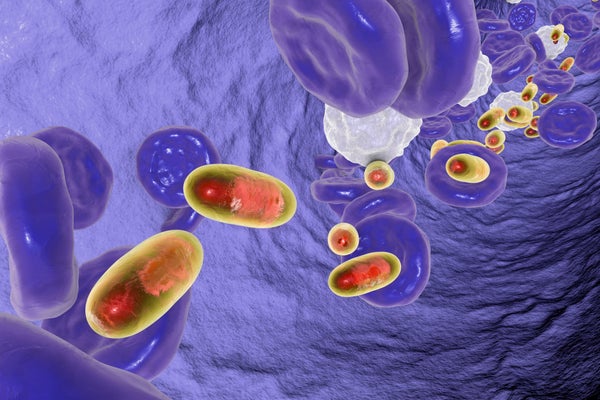This article was published in Scientific American’s former blog network and reflects the views of the author, not necessarily those of Scientific American
When we think of medical breakthroughs, our minds often turn to new drugs and treatments. However, innovations in biomaterials and medicine delivery processes are just as revolutionary and important as they pave the way for such advances.
At the Massachusetts Institute of Technology, we are working at this interface of biotechnology and materials science. Take something like a burn. We can effectively treat someone with an antibiotic ointment. However, a severe burn may require more advanced treatment, such as building a skin cell polymer scaffold that helps a patient regenerate their skin. That is where our work comes in. And it’s an example of how treatments are getting ever more personal to each patient.
One major focus for our team is developing polymers to deliver drugs continuously and at controlled rates for prolonged periods of time. In our research, we have created biomaterials and processes for everything from controlled drug release to tissue regeneration, and worked on anticancer drugs, gene therapy agents and vaccines alike.
On supporting science journalism
If you're enjoying this article, consider supporting our award-winning journalism by subscribing. By purchasing a subscription you are helping to ensure the future of impactful stories about the discoveries and ideas shaping our world today.
This means a better response to some of the limitations of human body, and particularly its central nervous system. When we take a drug orally, it can wreak havoc on the body as it carries medicine throughout our system. By engineering polymers that offer smart delivery systems, we can target specific parts of the body. This limits exposure and therefore adverse effects, offering more effective and precise treatment.
A good example of this is treating brain disorders. Drugs taken orally—such as L-DOPA, a dopamine precursor used to treat Parkinson’s disease, and Prozac, used to boost serotonin levels in patients with depression—can interact with neurotransmitters. These drugs have side effects because they act throughout the brain. What we can do instead is deliver medicine through a miniaturized cannula—a thin tube used to deliver medicine—that is connected to small pumps implanted under the skin. This technique can deliver tiny doses (on order of hundreds of nanoliters) into brain regions as small as one cubic millimeter, giving us much more control over where medication is dispensed, according to an individual patient’s needs. Research has demonstrated that this technology can control motor function. Down the line, it may help us treat tumors or neurological disorders such as Parkinson’s disease or Alzheimer’s.
Another exciting application of biomedical and technological innovation is telemedicine, or medical treatment from a distance. One example of this involves creating miniaturized wireless devices to treat chronic diseases or conditions that require frequent injections. Edible microchips could respond to wireless transmissions, and release drugs at sequential intervals into someone’s body to treat diseases. In theory, one could have a “pharmacy on a chip” that could dispense multiple drugs in regular and accurate doses.
Right now, we are starting to see more funding of personalized treatments. This includes personalized cancer vaccines, which use messenger RNA to make vaccines against a person’s own particular cancer. These treatments harness a patient’s own cells to fight disease and foster the development of vaccines against a particular cancer, rather than a one-size-fits all approach. Almost all RNA therapies use nanoparticles for delivery, making technological development key for delivering medication at the right scale.
This treatment is part of a broader interest in immunotherapy and cellular-based therapies, where I expect innovation will occur in the next 30 years. The goal here is harnessing the immune system to more effectively treat diseases. This means working at a small scale to achieve more effective results.
That being said, the fruits of these labors do take some time. Regardless of the research and innovation at hand, clinical trials and funding can have significant and unpredictable effects on timelines for medical innovation and adoption.
This makes it even more crucial that we encourage innovation and support scientists and engineers. They need the freedom to explore, learn and create. They must feel that there are no limits to what they can do, that they are doing something important; and we need to raise the profile of innovative new technologies so that other teams of scientists can develop further treatments. Awards like the Millennium Technology Prize help facilitate this; in fact, since I received the prize for my research, some of the greatest strides in personalized medicine have been made by teams from across the globe.
For most diseases and illnesses, we’re still at a stage where finding the right treatment is a process of trial and error; most patients are prescribed treatments because they have been proven to work for the majority, and if these don’t work then it becomes a long and costly process of finding the one that is effective. But, as the developments in the areas above show, scientists and engineers are beginning to make great strides in making medicine more personal.
Nominations for the 2020 Millennium Technology Prize opened on April 1, 2019 and are accepted until July 31, 2019. They can be received from organizations such as universities, research institutes, academies of science and technology, companies and industries, and can be awarded to an individual or to a team of any nationality. More information is at millenniumprize.fi.
